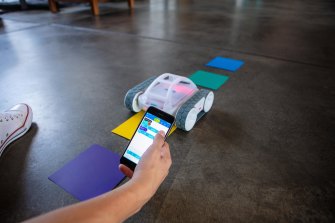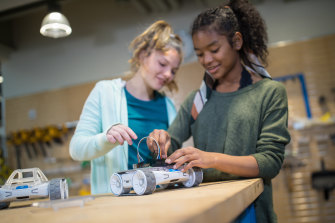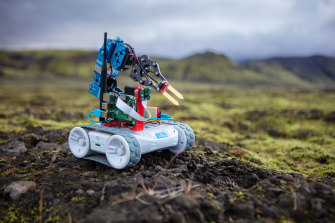Known for its programmable robot balls, Sphero took a few cutesy detours but is back on track with the $399.99 Sphero RVR; a fully programmable robot which can be controlled via Bluetooth from a computer, smartphone or tablet.
The RVR is an all-terrain vehicle, about the size of four iPads stacked in a pile. It's blessed with two tank treads, two electric motors and a removable rechargeable battery. Under the bonnet it features coloured LEDs and a range of sensors including a gyroscope and accelerometer.
The RVR has a range of sensor built in, including a camera to detect the colours it drives over.
The Sphero EDU app lets you drive the RVR around like a remote control car, but its real strength is the built-in block-style programming interface which is similar to the Scratch platform which many children use at school.
These onscreen building blocks let youngsters dive into programming and grasp concepts without needing to worry about learning syntax and writing lines of code. Instead, they can drag and drop programming blocks to create intricate flow charts which issue commands to the RVR, accept input from the onboard sensors and even connect with third-party hardware.
The fact the robot is a vehicle rather than just a ball certainly helps spark the imagination, with my 13-year-old daughter — a budding engineer — taking to the RVR with more passion than with the previous Sphero robots which have passed through our home.
The RVR features a basic camera on the bottom which can detect colours, and Sphero throws a few coloured cardboard squares in the box to get you started. My daughter soon had the robot venturing across the room, making different noises as it encountered the different coloured squares. Sadly the RVR lacks a built-in speaker so the sounds came from the iPad she was using to control it.
Programming is fundamentally problem solving so, when she managed to roll the RVR, I set her the task of determining how to make the robot's lights flash when it was tilting. This involved watching the real-time data feed from the onboard gyroscope as she tilted the robot in her hands, adding to the sense that the RVR brings programming into the physical world.
One shortcoming is that the RVR lacks the collision detection features found in some other Sphero robots, meaning you can't reliably use the "on collision" programming block. The expandable nature of the RVR means you can add extra sensors, but it's still disappointing considering the price tag.
Flexible hardware helps inputs and the results of programming be observed in the real world.
The beauty of Sphero's programming platform is its flexibility, including the ability to create custom blocks, so we worked around the problem by using the gyroscope as a makeshift collision detector. The onboard lights are handy when debugging your program.
Honing our collision detector, it became clear the onboard sensors aren't as tightly calibrated and consistent as some people might prefer; it's not enough to bother beginners but perhaps to frustrate perfectionists. The block-based programming interface also becomes fiddly on a touchscreen once your program grows long and complex.
Expandability means the RVR could suit a range of projects, but advanced skills might be required.
Support for other programming languages like JavaScript ensures the RVR has staying power when young programmers are ready to move on to new challenges.
To be fair, my daughter is more interested in the engineering side of things than programming. If you're looking for a flexible mechanical and electronics project then you might be a bit underwhelmed by the RVR as all the electronics, motors, gears and sensors are sealed and clearly not intended to be modified.
That's an understandable precaution considering Sphero wants to ensure the RVR keeps on ticking. It's a solid foundation, endowed with plenty of speed and enough torque to make it up a decent hill. Even so, tinkerers who are primarily interested in a mechanical and electrical engineering challenge might be better off buying a DIY robot tank kit paired by the likes of a Raspberry Pi.
That said, the RVR is expandable thanks to a USB port and 4-pin UART connector for hooking up a wide range of electronics to ride on its back; such as a Raspberry Pi, Arduino or littleBits.
This certainly adds to its staying power, but don't expect to be turning the RVR into a battlebot on day one. Thankfully there's a good collection of online tutorials and a growing community to help you on your way.
In a market that's flooded with short-lived programmable toys which are often one-trick ponies, the RVR's flexibility and Sphero's established ecosystem have the staying power to make this robot a wise investment.
While the RVR is primarily focused on programming, its expandability could also make it the foundation of a great electronics project to help inspire enquiring minds.
Source: Read Full Article



